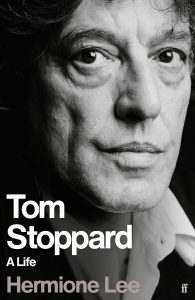 Published by Faber UK/Knopf US
Published by Faber UK/Knopf US
October 1 2020/ February 23 2021
Hardback, 992pp £30/ 876pp $35
Reviewed by N.J. Cooper
A famously nice man, although he claims not to be as nice as everyone thinks, author of some of the most successful, most admired plays of modern times, as well as some of the cleverest and funniest film scripts ever written, devoted father of four sons, lover and husband of beautiful and successful women, rich, admired, adored, revered, Tom Stoppard must have been a daunting subject for a biographer. Hermione Lee has tackled the challenge by giving us all the facts of his life and mostly restricting her own judgements in favour of the words of published critics or the people she has interviewed for this purpose, for example, ‘Julian Barnes thought this typically modest and funny.’
Born in Zlin, Czechoslovakia in 1937 to Dr Eugen Sträussler and his wife Marta, Tomáš was the younger of two sons. The family fled from the approaching Nazis eighteen months later. Dr Sträussler died on the journey and his widow and her boys found themselves in India. There she met an English major, Kenneth Stoppard, married him and moved to England, arriving on Valentine’s Day 1946. Tom and his brother were sent to prep and grammar schools and brought up as conventional English men. While his brother stayed on at school, Tom left at the age of seventeen to become a journalist in Bristol. There he was introduced to the world of theatre and actors by the Bristol Old Vic, and he was hooked. His first great success came in 1968 with the play Rosencrantz and Guildenstern are Dead.
Hermione Lee gives detailed synopses of all Stoppard’s plays, even the least significant, setting each one in the context of his life and ideas, as well as other work being produced at the time, some of which inspired him or gave him ideas. She shows how hard he worked to create the opportunities that came his way. Anyone hoping for a career in the theatre (or as any kind of writer) would do well to read each page of this long life to understand what he or she is undertaking. All the disappointments, the setbacks, the compromises, the battles not to compromise are here, and it is a tribute to Stoppard that he has made so few enemies along the way. Occasionally there are accounts of fallings-out but almost all are accompanied by a comment from the other person about how much they love him personally even though they are furious about whatever caused the disagreement. He is shown to be generous, described as the man you would want with you in a foxhole, and one who always pays his debts. He has given practical and financial support to Jews in Soviet Russia, to Vaclav Havel in Czechoslovakia and to Belarus.
Lee is careful in her descriptions of his relationships, again making no judgements. Clearly there have been pain and sadness along the way. After all he has had three marriages and two long relationships outside those marriages. But we are not made privy to anything very personal, and at one moment Lee writes simply that Stoppard refused to amplify a remark he made about something that troubled him at one particular time. At the end of the biography she alludes to a few negative comments made by people who know Tom Stoppard, but she does not explore the complexities of character the must lie behind his famous charm, which is a pity.
For the first part of his life he barely thought of himself as Czech and it wasn’t until 1978 that he told an interviewer, ‘I’m as Czech as Czech can be.’ This was after he wrote Professional Foul, the wonderful play that brought home to many of us at the time just how hellish life was in Communist Europe. Stoppard has been criticized by many on the Left for his conservatism, and he has always defended his views, writing for example in 2008 about the protests of 1968: ‘The “free West”, God knew, was all too often disfigured by corruption and injustice but the abuses represented, and were acknowledged to represent, a failure of the model. In the East, though, the abuses represented the model in full working order.’ He believes in the absolute importance of a free press, in individual liberty and individual responsibility.
It was even longer before he came to learn about his Jewish heritage and the sufferings of his mother’s family in the Holocaust, of which she never spoke. In 1999 he published an article in the first edition of Talk entitled ‘On Turning Out to Be Jewish’.
In between the day-to-day details of his life and work, Lee gives us some of his advice to other writers, for example a lovely description of good writing being sprung like a cricket bat, the timing of a joke and the need to make his audience work to understand it so that their pleasure in laughing is all the greater. What she does not give is any sense of what it is like to be in the audience of one of his great plays. We learn about the ideas behind the play, the plot, the actors involved, the director, often the staging and costumes, but the unmatched exhilaration and delight created by a performance of Arcadia, or Night and Day, or (for me) Hapgood are missing. As I read I felt I was perhaps being unfair to Lee. How could you reproduce such sensations on the page? Then at the very end of the biography she quotes Stoppard himself describing the magical conclusion to a performance of The Tempest at Oxford in the 1950s, which shows exactly how it’s done.
